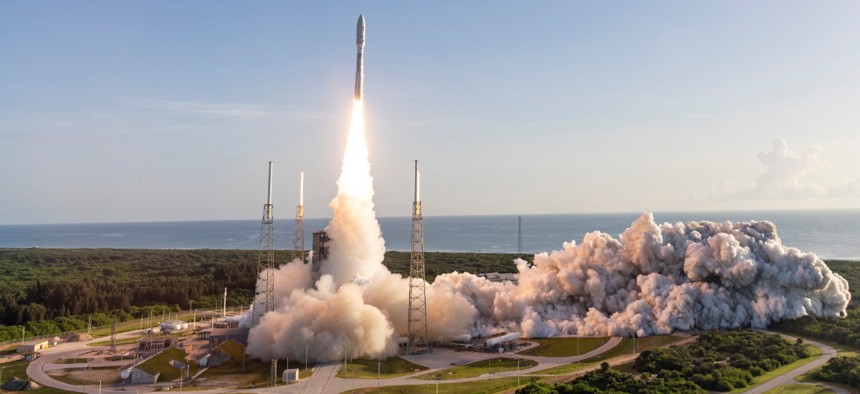Critical Update: NASA’s Big Plans For the Moon and Beyond

A United Launch Alliance Atlas V rocket carrying the Mars 2020 mission with the Perseverance rover lifts off from Space Launch Complex-41 at 7:50 a.m. EDT on July 30, 2020. United Launch Alliance
It’s a new era of spaceflight for America’s space agency.
The aim of NASA’s iconic Apollo program was as complex as it was straightforward: Land humans safely on the moon and return them back to Earth before the end of the decade. Sustaining human spaceflight and a presence on the moon for years to come was not a primary objective at the time.
But for NASA’s contemporary missions and particularly Artemis—a program aimed at landing the next man and first woman on the moon in 2024, aptly named for Apollo’s twin sister—the intent now is different.
“The strategy overall is to go back to the moon, prove out the technologies and capabilities—not to stay at the moon, but to move on to Mars,” NASA’s Chief of Staff Gabe Sherman said on the latest episode of Nextgov’s Critical Update podcast. “We want to have a permanent long-term presence, sustainable presence at the moon. But we don't want to stop there, we want to make sure that everything that we're doing has a purpose and moving us closer to that end goal, which is putting an American flag on Mars.”
Sherman, as well as Smithsonian Curator and Space and Technology Historian Dr. Teasel Muir-Harmony and Astrobotic CEO John Thornton explored the “thens” vs. “nows” of NASA’s ambitious pursuits—highlighting notable cultural nuances and historical context about spaceflight and traversing the solar system, along the way.
For instance, while the space agency has long worked with contractors on space endeavors, historically, NASA has usually been the owner and operator of the spacecraft and hardware used on its deep space missions. Until now.
The agency is proving out the business case in which it becomes the customer. As Muir-Harmony, curator of the Smithsonian National Air and Space Museum’s Apollo Collection put it, companies are presently “responsible for more elements of the flight.”
Still, “there's always been a really important relationship between NASA and private industry,” she noted.
To Sherman, ups in space commercialization mean more flexibility for the evolving agency.
“NASA needs great commercial partners to come alongside us and help stretch our resources,” he said, adding that “whenever we depend on the commercial companies to do things like take our astronauts back and forth to low-Earth orbit, it helps reduce costs for us, and helps us invest those dollars to go do the bigger things, right? To lead at the moon and to lead at Mars.”
Pittsburgh-based space robotics-creator Astrobotic is one commercial company that intends to expand space accessibility. In June, NASA selected the business for a $199.5 million CLPS mission to deliver the space agency’s Volatiles Investigating Polar Exploration Rover, or VIPER, to the moon’s South Pole in late 2023.
“It will be going over to the permanently shadowed parts of the moon and be drilling for water. That might sound mundane because water is all over Earth. So, why is that important in space?” Astrobotic CEO John Thornton explained. “Water in space could be like oil is here on Earth—and one of the first commodities and one of the first fuels that we use to get in and around our solar system.”
Calling space “the new frontier,” Thornton said making it more accessible could potentially improve life on Earth.
“For example, there are rocks that are orbiting our sun today that are worth trillions of dollars because of the vast amounts of metal, and rare earths and gold and platinum that are in these rocks,” he said. “So, imagine if we could go mine those rocks instead of digging big giant holes here on Earth and polluting our delicate blue marble.”
The space-aligned officials further detailed what’s to come, reflected on NASA’s increasing inclusion of women and minorities, and noted that while the internet makes information about space travel more accessible today, the overall national context is vastly different than the Apollo years.
“I think it's important to look at those differences when we talk about why we're going to space and what its meaning is—and what its larger social, cultural and political impact might be,” Muir-Harmony said.
You can also download and subscribe to Critical Update in the Apple Podcasts or Google Play.






